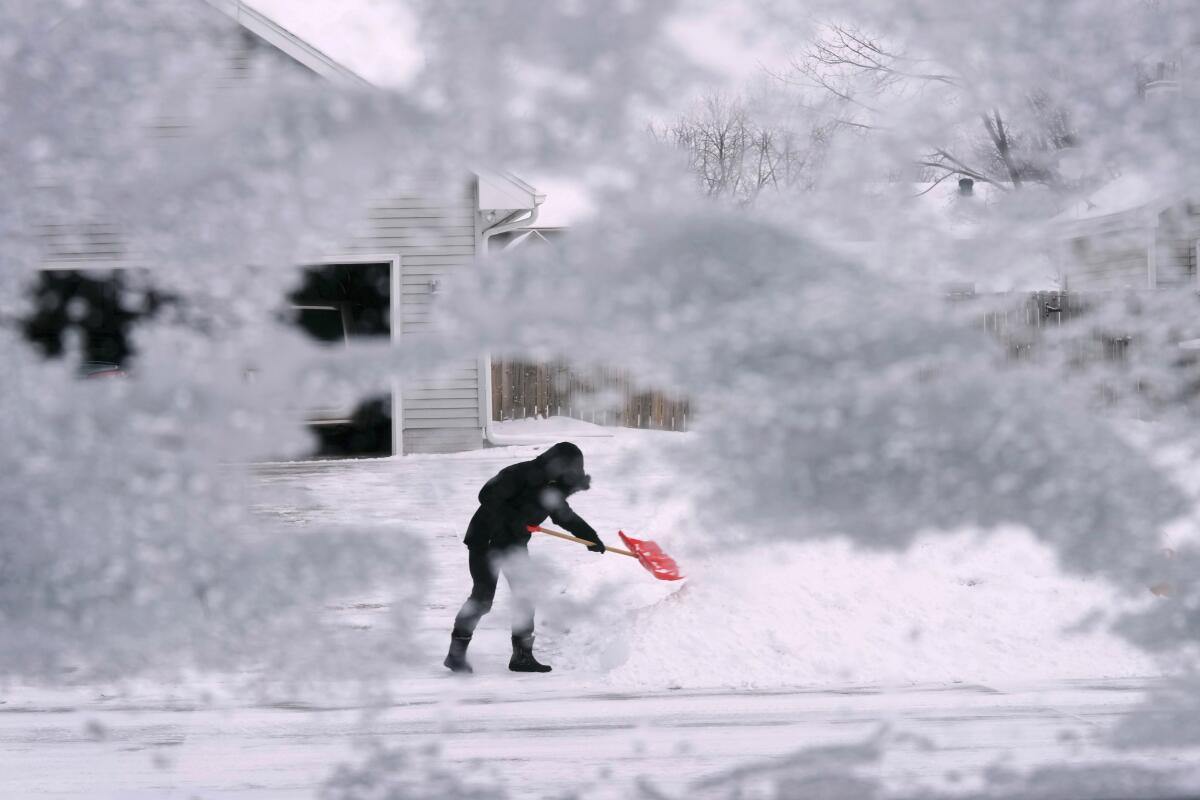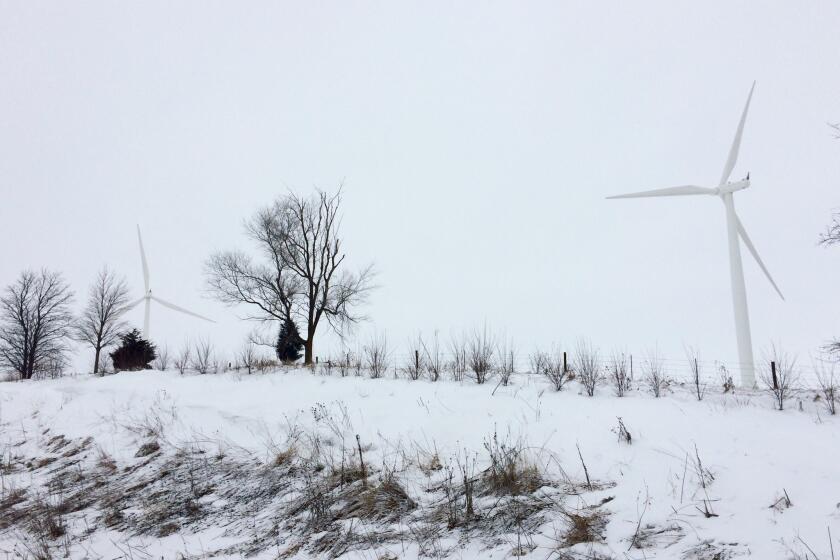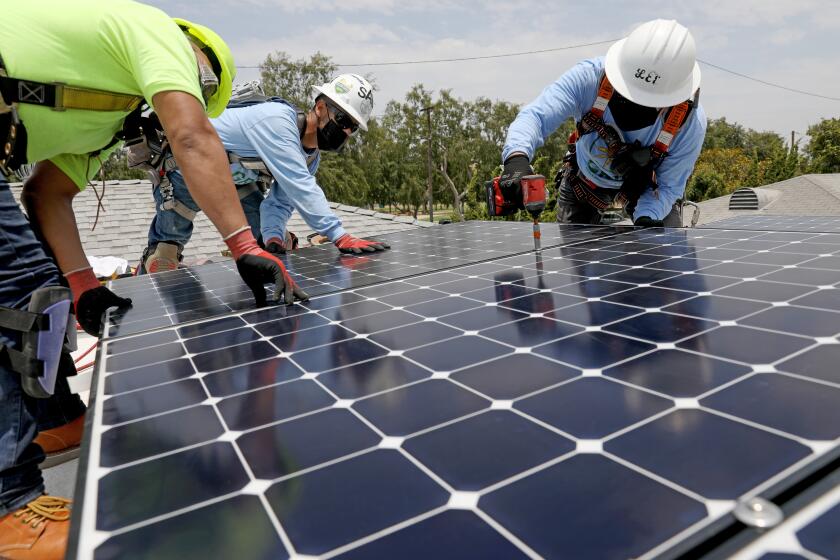Deadly winter storm exposes deep flaws in the U.S. energy system

- Share via
The deep freeze that blanketed most of the U.S. in the last few days killed dozens of people and temporarily plunged millions into darkness.
Yet the country narrowly escaped an even worse calamity as natural gas and power supplies buckled across several states, laying bare just how vulnerable the electric grid has become to a full-on catastrophe in the face of climate change.
The storm evoked memories of a deadly 2021 winter blast that caused widespread blackouts in Texas.
But whereas that system hit a region unaccustomed to extreme cold, this one spread across the Midwest and Northeast — two areas that should be well-prepared. The fact that they weren’t highlights the flaws of a system that’s facing limited natural gas supplies and the unpredictability of solar and wind power.
“These cold fronts expose the fragility of our energy systems,” said Michael Webber, an energy resources professor at the University of Texas in Austin. “Though the variability of wind and solar are well known and discussed a lot, these freezes also show the flimsiness of the gas system.”
The energy emergency is a “systemic failure,” with major climate change implications.
Supplies of natural gas, the nation’s primary heating and power-generation fuel, plunged the most in more than a decade as wells froze and pipelines failed, sending prices skyrocketing.
The nation’s largest power grid was on the brink of forced rotating outages, while power was knocked out at least briefly to some customers in at least 24 states. Storm-related deaths reached at least 27 in Buffalo, N.Y.
It was the sheer size and scale of the storm that made it so unusual, along with temperatures as cold as minus 50 degrees in some places. An extreme dive by the jet stream across North America drove the wedge of cold air across a huge swath of the country.
With cold blasting so much of the nation at once, power grids weren’t able to rely as much on neighboring systems to help bolster supplies. It’s the kind of event that could become more common — sharp kinks in the jet streams are a hallmark of the changing climate.
On Dec. 23, U.S. natural gas production suffered its worst one-day decline in more than a decade, with roughly 10% of supplies wiped out because of well freeze-offs. Output was as low as 84.2 billion cubic feet on Saturday, a 16% decline from typical levels, before a slow recovery started, according to BloombergNEF data based on pipeline schedules.
Billionaire Phil Anschutz — who owns the Coachella music festival, the Los Angeles Kings hockey team and L.A.’s Crypto.com Arena — is preparing to build the nation’s largest wind farm. We traveled the route.
That means suppliers were relying heavily on inventories of gas held in salt caverns and depleted aquifers to keep up with demand, which climbed as high as 144 billion cubic feet on Friday.
Most of the output loss was seen in the northeastern Appalachia basin, where supplies plunged to the lowest level since 2018. U.S. natural gas futures posted gains on Tuesday as supplies remained severely constrained by freeze-offs.
Supplies from Appalachia to the Tennessee Valley and the Midwest more than halved from typical levels, according to pipeline flow data compiled by BloombergNEF. Issues were exacerbated by mechanical problems with pipeline infrastructure, including at a compressor station in Ohio operated by Enbridge Inc.’s Texas Eastern Transmission Co., which invoked force majeure on some gas supplies.
The Tennessee Valley Authority, a federally owned power provider to several Southern states, and Duke Energy were forced to order rolling blackouts to conserve energy.
On Friday, physical deliveries of gas at a hub supplying the Carolinas and Virginia traded at $60 per million British thermal units, up nearly 650% from only two days earlier. That’s also more than eight times the price for gas delivered into the Henry Hub in Louisiana, the U.S. benchmark. By Saturday, gas topped $100 in Washington and parts of New England.
Want to go solar, and maybe add a battery? Here’s what you need to know.
PJM Interconnection LLC, the largest U.S. grid operator with lines spanning Illinois to New Jersey, declared a rare emergency on Christmas Eve, requiring some of its 65 million customers to curtail demand while warning of the possibility of rotating outages. The grid also appealed to households to conserve over the weekend.
In Texas, the Energy Department granted an emergency waiver to allow power plants to keep running without violating an emissions limit.
This is the third winter in a row that freeze-offs caused natural gas production to drop at least 8 billion cubic feet a day, underscoring the increased frequency of output-disrupting storms.
Natural gas is now the leading power-plant fuel, overtaking coal thanks to the shale boom that kicked off more than a decade ago. The fuel was so expensive that New England was relying on oil for up to 40% of its power over the Christmas holiday weekend.
Systemwide impacts for natural gas and electricity are “making it difficult to dismiss February 2021’s Winter Storm Uri as a one-off event,” said Eli Rubin, an analyst at EBW AnalyticsGroup.
More to Read
Inside the business of entertainment
The Wide Shot brings you news, analysis and insights on everything from streaming wars to production — and what it all means for the future.
You may occasionally receive promotional content from the Los Angeles Times.











